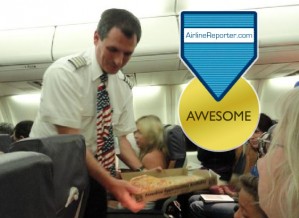
Southwest Airline's pilot hands out pizza. Awesome!
With all this talk about how airlines treat passengers horribly when they are stranded, good news comes from Southwest Airlines — which earns them an Awesome Medal!
A Southwest flight from Fort Lauderdale, FL to Denver, CO ran into some stormy weather and had to be diverted to Pueblo, CO. Anyone who has been on a diverted flight, knows it is not a fun experience. But in this instance, the crew stepped up and got the passengers pizza.
I spoke with Chris Mainz, with Southwest, about this unique customer service experience. He pointed out that Pueblo is not an airport usually served by Southwest and it was a team effort between the flight crew and airport personal. I asked if Southwest had any policies regarding what the flight crew should do in these instances and he told me there are no written rules or policies and Southwest trusts their employees to do what is right.
You always hear people complaining about losing the “good ‘ol days of flying,” but dang, I don’t even think airlines of yesteryear did this.
Cheers to the flight crew, Southwest Airlines, and the Pueblo Memorial Airport for providing this awesome service. This proves you still can have low fares and amazing (I didn’t want to use “awesome” again) customer service!
Source: WSBTV Orig Image: James Mino via WSBTV
connect | web | twitter | facebook |
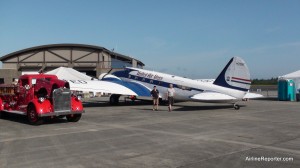
Boeing 247 from the Museum of Flight
What a beautiful and sunny day to be hanging around a bunch of airplanes and aviation enthusiast. This Saturday I was able to spend a few hours at Paine Field for the General Aviation Day put on by the Washington Pilots Association and Snohomish County’s Paine Field.
Not only were there amazing historical aircraft, but people from all around flew their personal planes and also had them on display (I was sad I had to drive). Even though there were lots of impressive aircraft, seeing pilots donate their time and fuel to fly 8 to 17 year olds for free really put a smile to my face. The Young Eagles allows kids the chance to try out aviation and get the motivated to fly. Two rows of personal planes (ranging from Cessnas to Bonanzas) were lined up ferrying over 220 kids up into the blue sky. Every child coming off those planes had a smile from ear to ear. What a great program! If you have an airplane and want to share the experience of flight to children, join on up (If you have an airplane [or helicopter] and want to fly an almost 30yr old blogger, email me :)).
Unfortunately I had to leave after a few hours because of other engagements, but Liz Matzelle (@ImperfectSense) was there to take wonderful photos of the aircraft in flight [which is great, because Liz has a wonderful eye when it comes to photography and took better photos than I could have :)]
If you missed out this year, don’t worry, I am sure it will be back next year. It is definitely worth the drive and the free admission! Until then, if you are a pilot or have an interest in general aviation, looked at joining the Washington Pilots Association — they work hard to keep the spirit of general aviation alive in Washington state!
Fun Media For You:
* All my photos from the day’s events
* Amazing photos from Liz Matzelle
* General Aviation Day Photos 2010 from Bill Gardner
* General Aviation Day Photos 2009 from Bill Gardner
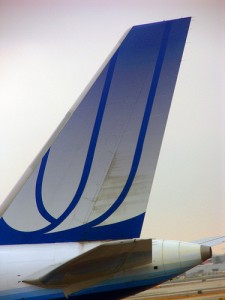
United Airline's tail could use a little wash
On April 17th, 18 year old Jessica Cabot was flying from British Columbia to Florida, when she ran into some trouble while on a stopover in Chicago. Cabot is blind and she was waiting for flight attendants to escort her off the plane, but no one came. When she heard the plane door shut and latch she started to panic. After ten minutes two maintenance staff found Cabot and assisted her. She was told to wait until after all the passengers go off, then someone would assist her off.
After complaining to United, Cabot received a $250 airline voucher and a promise she would receive an apology. However, it took United five weeks to connect with Cabot and apologize. “They just called,” said Cabot. “I can’t even count how many times they said sorry.”
Sarah Massier, a spokeswoman with United Airlines in Chicago, said Cabot had a longer delay in getting an escort than expected. “We apologized to Ms. Cabot for the delay in providing her an escort, and have taken action with our employees and vendors at O’Hare to ensure this does not happen again.”
Cabot was told that the flight attendants were mortified Cabot was left behind. “She said they had done their sweep of the plane and I was a tiny girl,” said Cabot, who is 5-foot-3. “Does that mean if you’re short they’re not responsible?”
Cabot is returning home on a Delta flight soon and says she still plans to fly United (maybe just for the $250 voucher).
This comes after Air Canada Jazz recently left a sleeping passenger in one of their planes. This is not only bad customer service, but a huge safety issue. I know a lot of flight attendants are exhausted by the time they reach their final destination; I just can’t understand how a person can be missed.
Source: The Vancouver Sun Image: SFPhotocraft
connect | web | twitter | facebook |
Double good news from Boeing on the Boeing 737. Boeing announced they will sign a 40 year contract with Renton Municipal Airport to keep flying new Boeing 737’s from their plant next to the airport. Boeing states they have no plan to move Boeing 737 production from Renton, WA up north to Everett, WA (where the Boeing 767,777, 747 and 787 are made) or to another location in the country.
Boeing also announced their plan to ramp up production for the 737 from 31.5 units per month to 34. Boeing expects orders for the 737 to increase with the global economy improving.
connect | web | twitter | facebook |
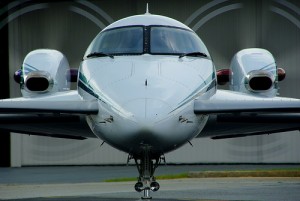
N514RS Starship Beechcraft from the front
About a month ago, I challenged myself to fly on a Beechcraft Starship and I have secured a ride! I get goose bumps just thinking about it.
I have been very surprised how many people have emailed me with suggestions and personal stories of the Beechcraft Starship. There truly is a great following and people love this plane. I thought I might be one of the biggest fans out there, but I might have some competition for that title.
Shortly after my first post I started getting emails suggesting I contact the same person: Robert Scherer. He owns Starship NC-51 (N514RS). He also bought left over Starship parts and runs Starfleet Support (no, not a Star Trek thing), which provides parts to the remaining flyable aircraft. I was also told that Scherer is a pretty cool guy and has a genuine love for the Starship. My readers were right!
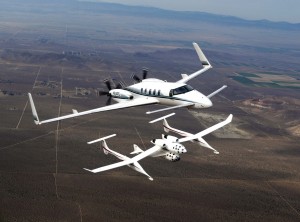
NC-51 - Primary chase for Scaled Composites' Tier One Program. How cool.
I tracked down his contact information and sent over an email. He replied that he would be more than happy to help me out in my quest. AWESOME (I know I use that word a lot, but I REALLY mean it this time)!
NC-51 is one cool Starship. It has been used as the chase plane for Spaceship One, White Knight 2, and is even signed by Burt Rutan (the father of the Starship – click that link, pic of Rutan at the door of NC-51).
Scherer is based out of Aspen, CO (ASE) and routinely flies over to Orange, CA (SNA). I have been invited to go with him on one of his flights in the next few months.
When he flies this route, he leaves ASE and heads to Meeker (EEO) for cheap gas. This is a low level, 15 minute flight over some beautiful terrain. Then he goes around 34,000 feet to fly from EEO-SNA. Want to see what the first leg of the flight looks like? Scherer has a video of one of his flights from ASE to EEO. Um…yes please.
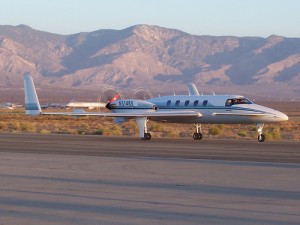
N514RS ready for take off from Mojave, CA
This blog has given me quite a few amazing opportunities since I started it in July 2008, but I have to say this one excites me the most. You can be sure there will be lots of video, photos and Tweets from this wonderful experience.
A HUGE thanks to Robert Scherer for giving me and my readers this great opportunity!
OTHER MEDIA:
* See Scherer talk about the Starship on History Channel’s Boneyard
* Video of NC-51 cockpit
* If this professional video of NC-51 doesn’t gives you goose bumps, you aren’t a true Starship fan
* Cockpit night landing of NC-21 into Austin, TX
* See what happened to every Starship
My Quest to Ride on a Beechcraft Starship:
IDEA | CONNECT | TOUR | FLIGHT-PLAN | FAIL | FLIGHT | PHOTOS | VIDEO
Images: #1 Carlos J Images, #2 Rob Scherer, #3 kittel





